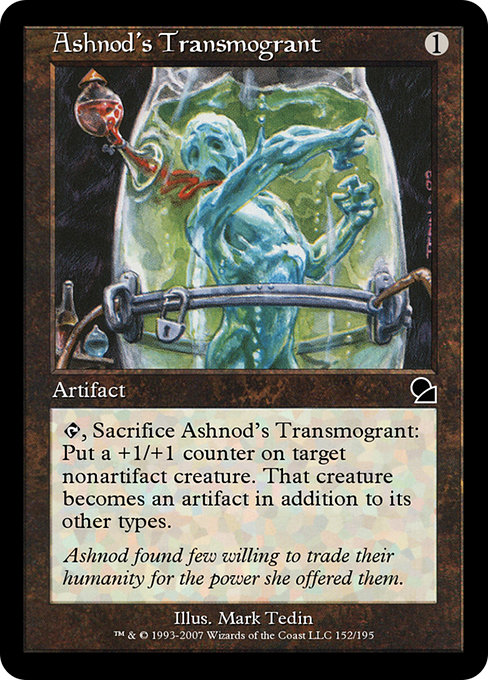
Image courtesy of Scryfall.com
Revisiting a Classic: A Closer Look at an Original Lore Thread
In the grand tapestry of MTG lore, Ashnod's Transmogrant is a small card with a big idea: transform life into something metal, and do it on a bargain-basement budget of one mana. Released as part of Masters Edition—a reprint line that saved many a vintage deck from the price of gold—the card’s crisp oracle text still feels gleamingly modern. For players who love the old-school vibe, it’s the kind of card that makes you grin at the idea of turning a living creature into an artifact, a concept that sits at the intersection of necromancy and machinist’s craft. 🧙🔥💎
Original Lore and the Ashnod Mythos
The flavor text anchors the moment in a mythic cadence:
Ashnod found few willing to trade their humanity for the power she offered them.This isn’t just window dressing; it’s the card whispering to players about the moral cost of power. Ashnod herself is a figure who appears across early MTG lore as a master of life-forged machinery, a person who believes that the price of magic is often humanity turned to metal. The Transmogrant, then, is more than a utility artifact—it’s a narrative device, a tiny lens into a larger world where beings flirt with the idea that flesh can be upgraded into something colder, sharper, and more enduring. It’s the moment a card stops being just numbers and starts telling a story that fans discuss over coffee at GP booths and on old MTG forums. 🎨⚔️
Mechanics in Practice: A Small, But Sharp Tool
From a gameplay perspective, this is a lean, one-mana question with a surprising depth. Tap this artifact to sacrifice it, put a +1/+1 counter on a target nonartifact creature, and watch that creature become an artifact as well. The effect is clean, but its implications are layered:
- Cost and tempo: The activation costs a tap and a sacrifice, so it’s a burst of utility that you reserve for the right moment. In formats that value low-cost boards and artifact synergies, this can produce a tempo swing or a surprise protector. ⚡
- Creature type and vulnerability: Only nonartifact creatures can receive the buff. Your artifact creatures—if you happen to have any—are off limits for this spell, which nudges players toward careful timing and deck-building nuance. 💎
- Artifact conversion: The moment the buff lands, the target creature also gains artifact creature status. That broadens what you can do with it—think of it as unlocking new lines of interaction with equipment, auras, or other artifact-enchantment tools. It’s a double-edged blade: more power, but more exposure to artifact-targeted removal. 🧰
In Masters Edition, where many players chased nostalgia and reliable performance, Ashnod's Transmogrant offered a practical, flavor-forward toolbox option. It’s the kind of card that reminds you how MTG’s designers sometimes tucked clever, pocket-sized ideas into a simple one-drop. It’s not a modern combo piece to win next turn, but it’s a thoughtful inclusion in any artifact-curious or nostalgia-driven build. 🧙♂️💡
Art, Flavor, and the Transmogrify Theme
Mark Tedin’s artistry brings the concept to life with a confident stroke that blends arcane glyphs with practical machinery. The art’s tonal palette leans toward the dark, metallic sheen of a world where magic and metal fuse. The transmutation process feels intimate here—like a ritual that reshapes a creature’s destiny as surely as a blacksmith reshapes metal. That emotional imprint is part of why the card’s lore-leaning angle still resonates with players who love storytelling in their decks. The Transmogrant isn’t just a tool; it’s a narrative prompt that invites you to imagine the moment when a living thing passes behind the door labeled “artifact.” 🎨🧭
Masters Edition and Collectibility
As a common in the Masters Edition reprint line, Ashnod’s Transmogrant is affordable, present in both foil and nonfoil finishes, and a scholarly nod to timeless cards. The Me1 set—while short compared to today’s expansions—was a love letter to nostalgic gameplay, a chance for new players to own classics without chasing the wild price tags of original printings. For collectors, the card’s association with Ashnod’s broader mythos—combined with the vintage frame and a crisp illustration—makes it a welcome guest in any “nostalgia-first” binder. The data from Scryfall places a modest index for MTGO tickets around 0.04, underscoring its status as a budget-friendly, flavor-rich piece. 🪙🎲
In formats that welcome artifact play, including certain Legacy and Commander circles, this card can still find a home as a thoughtful nod to the past that asks the question: what would you sacrifice on the altar of power? The interplay of turning a living creature into an artifact creature invites you to explore themes of control, protection, and the cost of enchantment-driven strategies. And while it won’t win you the game outright, it might just tilt the board at the moment you need a spark of inevitability. 🔥💎
For fans who want to explore more about the card’s history or want to see the full list of related prints and how the card has traveled through time, Scryfall remains a vivid portal into the me1 lineage and beyond. And if you’re hunting a real-world companion for your MTG habit—one that doubles as a tactile reminder of the multiverse’s weird, wondrous corners—check out the product link below and bring a little MTG-inspired design into your everyday carry. 🧙♀️🎲